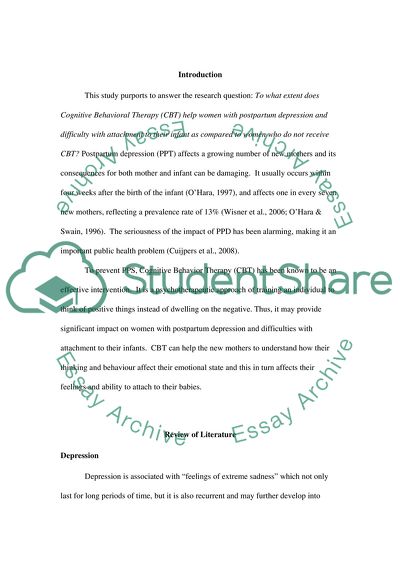Cite this document
(Cognitive Behavioural Therapy as an Intervention for New Mothers Post Research Proposal, n.d.)
Cognitive Behavioural Therapy as an Intervention for New Mothers Post Research Proposal. https://studentshare.org/health-sciences-medicine/1752930-can-cognitive-behavioral-therapy-help-women-with-postpartum-depression-and-difficulties-with-attachment-to-their-infant-as-compare-to-women-that-does-not-receive-cbt-treatment
Cognitive Behavioural Therapy as an Intervention for New Mothers Post Research Proposal. https://studentshare.org/health-sciences-medicine/1752930-can-cognitive-behavioral-therapy-help-women-with-postpartum-depression-and-difficulties-with-attachment-to-their-infant-as-compare-to-women-that-does-not-receive-cbt-treatment
(Cognitive Behavioural Therapy As an Intervention for New Mothers Post Research Proposal)
Cognitive Behavioural Therapy As an Intervention for New Mothers Post Research Proposal. https://studentshare.org/health-sciences-medicine/1752930-can-cognitive-behavioral-therapy-help-women-with-postpartum-depression-and-difficulties-with-attachment-to-their-infant-as-compare-to-women-that-does-not-receive-cbt-treatment.
Cognitive Behavioural Therapy As an Intervention for New Mothers Post Research Proposal. https://studentshare.org/health-sciences-medicine/1752930-can-cognitive-behavioral-therapy-help-women-with-postpartum-depression-and-difficulties-with-attachment-to-their-infant-as-compare-to-women-that-does-not-receive-cbt-treatment.
“Cognitive Behavioural Therapy As an Intervention for New Mothers Post Research Proposal”. https://studentshare.org/health-sciences-medicine/1752930-can-cognitive-behavioral-therapy-help-women-with-postpartum-depression-and-difficulties-with-attachment-to-their-infant-as-compare-to-women-that-does-not-receive-cbt-treatment.


